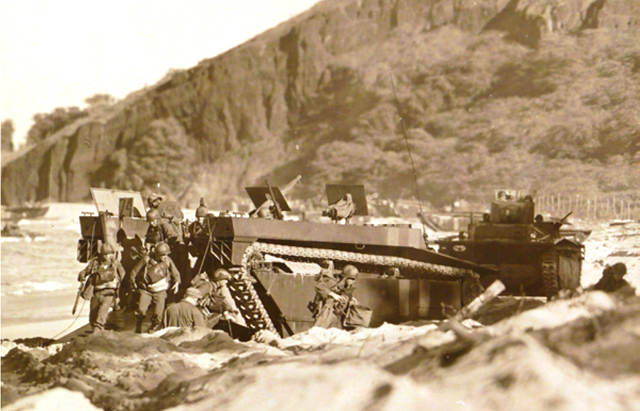
Amphibious Tractors (AMTRACS) aka Landing Vehicles Tracked (LVTs) on Big Beach, Makena, Maui, 1945. Some of these vehicles sunk in coastal waters and are now some of our Maui wreck dives.
During WWII the Kihei-Makena coastline of Maui was an important training area for U.S. Marines headed to the Pacific. The sandy beaches were good for practicing beach assaults with amphibious tractors (AMTRACS) which were also known as LVTs (Landing Vehicles Tracked). For unknown reasons, some of these vehicles ended up submerged in relatively shallow water (60-80 feet), and are now some of our favorite Maui wreck dives.
Several times a year, large surf rolls in from far out at sea bringing surf to our Kihei-Makena coastline and carving out the beaches. Less visible is what that surf does to the sand in deeper water, particularly around some of our Maui wreck dives. It causes the sand to shift, to form drifts in some areas and depressions in others. And in that process, every few years, the sand seemingly gives birth to an object that had been buried for years. If we divers come along in that critical few days, before it sifts back below the sand, we receive a nice surprise – and an education.
The Discovery
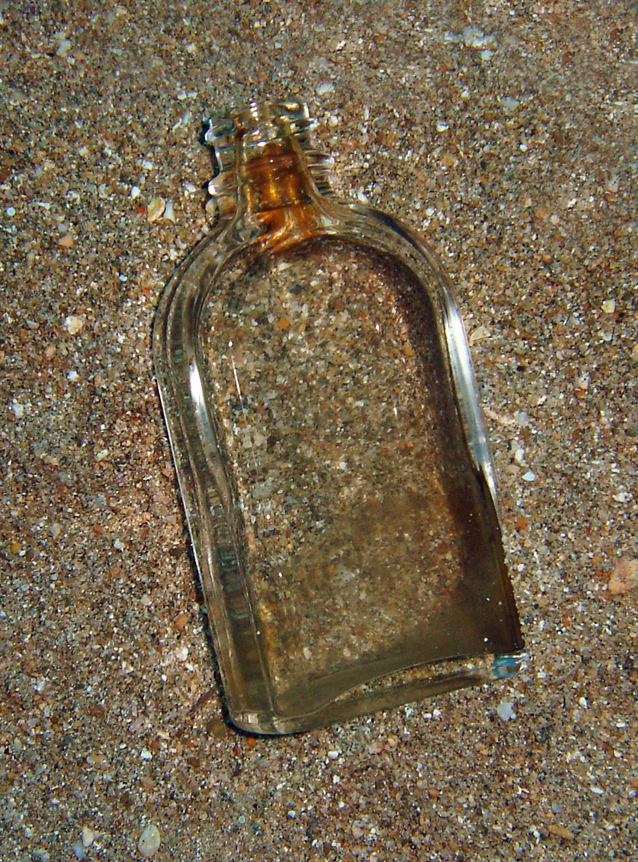
Small bottle found and photographed by Autumn Hill near sunken WWII LVT off Makena, Maui. Bottle height about 9 cm.
Autumn Hill (AJ) was one such lucky diver last week. While diving near a WWII LVT she noticed a shiny glass object partially exposed on the sand. When she fanned the sand away, she saw that it was an elegant little glass bottle. Because of its proximity to the wreck, it was most certainly old, so she photographed it in place so that we could do a little research, and then reburied it.
The bottle was in beautiful condition and had no growth on it, as if it had been buried under sand since the craft’s sinking. It was about 9 cm tall and looked as if it had held only about 2 ounces of liquid. Our first thought was that it had held some sort of toiletry or medicine belonging to a U.S. Marine. However, the identifying label was long since gone, so we had to rely on bottle characteristics to determine its true purpose.
The Research
Fortunately, the bottom of the bottle was embossed with both the Patent Number and the logo of the bottle manufacturer. Adding to our luck, this bottle came to the surface after the invention of the internet!
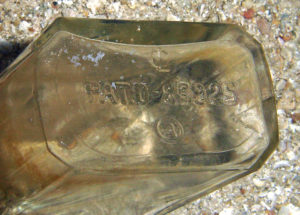
Patent Number D-85925 on bottom of bottle. Photo by Autumn Hill.
First we focused on the Patent Number (PAT.D-85925) embossed on the bottom of the bottle. The number was easily found on the comprehensive website, Google Patents. There we learned that this patent was granted in 1932 for a bottle design which matched this one exactly.
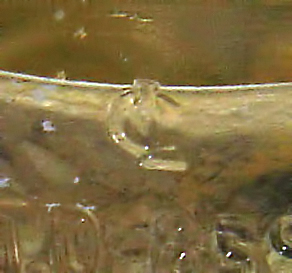
Bottle manufacturer logo on bottom of bottle. Photo by Autumn Hill.
The logo appeared to be a C partially over lapping an L. Thanks to another incredible website cataloging glass bottle marks we learned that the bottle was made by Carr-Lowrey Glass Company in Baltimore, Maryland! This company made bottles from 1889-2003. If you were around in the 1960s you may remember Avon bottles in the shape of cars or animals or other quite random objects. Carr-Lowrey was one of the companies that made these bottles. Just to know where this little bottle had been manufactured was exciting in itself. But all this didn’t tell us what had been IN the bottle.
The Curious Earhart Connection
Coincidentally, a fragment of a bottle with this same Patent Number had been found on Nikumaroro (formerly Gardner Island) in 2007. Researchers from The International Group for Historic Aircraft Recovery (TIGHAR) analyzed this bottle fragment – in context with other artifacts – and theorize that it belonged to Amelia Earhart, the pilot who disappeared in 1937. A research bulletin describes their process of determining the original contents of that bottle. Using the bottle shape, patent number and chemical analysis of the residue on the fragment, they believe that it contained the best-selling hand lotion in the 1930s, Campana Italian Balm. Since lotions at that time were marketed mainly to women, it fit well with their theory that Earhart may have ended up as a castaway on that island after she and her plane vanished.
Lotion, however, didn’t seem to be a good fit for this bottle belonging to a typical U.S. Marine in the 1940s. We wondered if perhaps The Campana Company had made hair tonic or another more manly product and had used the same type of bottle.
A check of Wikipedia showed an entry for The Campana Company. There we read that during WWII the company had changed the name of its best-selling lotion. Due to growing anti-Italian sentiment they had changed it from Campana Italian Balm to Campana Balm. From this, we at least knew the lotion was still being made in the 1940s, making it possible that this is what was contained in “our” bottle. But the most surprising Wikipedia statement was this: “Campana Balm was carried by every U.S. soldier and serviceman to prevent or heal burns.” This seemed to indicate that perhaps “our” bottle had contained lotion after all!
But, we couldn’t find any corroboration or reference to back up that sweeping statement – not one reference to U.S. marines or soldiers using this lotion. And it seemed strange that the U.S. Military would not have had its own standard-issue burn cream. Also contributing doubt is the fact that some people vigorously dispute the Earhart/Nikumaroro theory. Somewhat heated discussions can be found online, and some people have strong opinions and theories about what happened to Earhart. It seems possible that someone added this statement to Wikipedia hoping to promote their opinion that the bottle did not contain lotion and belong to Earhart. They may have hoped to offer an alternative theory that the bottle belonged to a U.S. serviceman instead. But we had our doubts, so we kept researching.
The Answer!
We wondered what items a typical WWII Marine’s first aid kit would have contained, and searched for photos and equipment lists online. On the WWII US Medical Research Center website, we found a list and the photo below. This Individual Medical Jungle Kit was available beginning in 1944 and was specific to Marines headed to the Pacific. As such, it contained a critical item not needed in the European theater – insect repellent! And the 2 oz. bottle that held it was the very same design (and in some cases the same bottle patent number) as the one that AJ photographed in the sand!
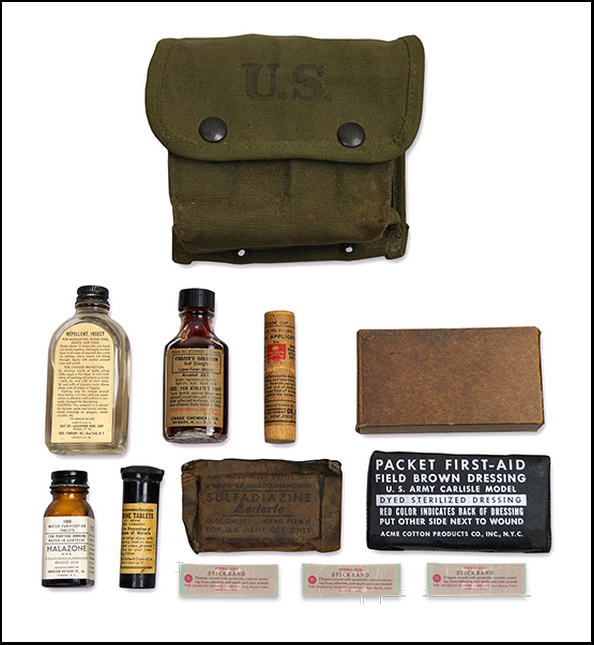
M-2 Jungle Medical Kit issued to U.S. Marines in 1944. Photo from https://www.med-dept.com/articles/individual-first-aid-kits/
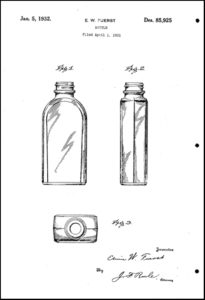
Patent application D-85925 from E. W. Fuerst found on Google Patents.
AJ’s discovery of this bottle proved to be a fun little research project that expanded our minds in several ways.
At this point in time each of us has seen thousands of products and containers, either in person or on TV. In this context, the design in the bottle’s patent application (to the right) looks so simple to us today. It is an elegant reminder that even the most basic items had to be “invented.”
We learned that you can’t believe everything you read on Wikipedia. The comment that every soldier carried Campana Balm appears to us to be unsubstantiated.
And finally we learned that the ocean will never be finished revealing its treasures. All it takes are the right sea conditions and the right diver for another little mystery of the sea to be discovered.
Written by Pauline Fiene. Photos as credited.
***********************

Comments 12
Thank you for yet another engrossing and educational blog post, Pauline!
What an engaging read! Thanks, Pauline. And it has been way too long since I’ve been diving with y’all (like 15 years!).
Wonderful read! I love your curiosity! Good research!
So neat you found the history on this bottle!
Awesome article and stellar find AJ!
Great story! Hope all is well with you. I’ll try to get to Maui this year and am looking forward to diving with you. It’s been too long!
Ciao Pauline anche io sono un sub ma anche un cercatore di oggetti risalenti alla seconda guerra ed è proprio sulla linea gotica nella mia Toscana che la mia ragazza ha ritrovato una bottigliette identica alla tua probabilmente appartenuta ad un marine ancora sigillata e piena.
Translation: Hello Pauline I am a diver but also a finder of objects dating back to the second war and it is right on the gothic line in my Tuscany that my girlfriend has found a bottle identical to yours probably belonged to a marine still sealed and full.
Author
Grazie Sandro for commenting. It was fun to research it wasn’t it? Lovely bottle.
I have a bottle with the same patent numbers. It still has liquid in it!
I have found one at a USAAF Airbase dump with 1 and a half small white tablets in it
Author
Hi Neil. Do you have a photo of it? The opening at the top of our bottle seemed too small for tablets and appeared to be for a liquid.
Pingback: A Memorial Day remembrance of the servicemen who trained on Maui during WWII